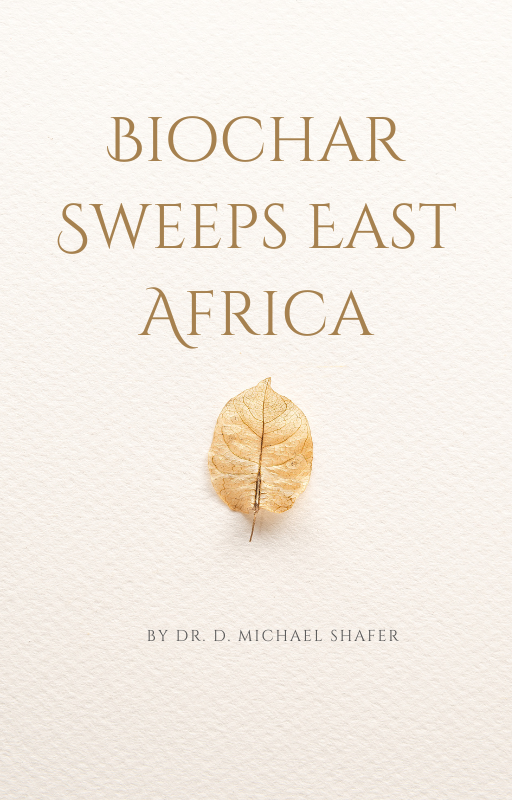Biochar in Africa
|
When most people think of East Africa, they visualize great roaming herds of wildebeests and mighty lions; most of those who live in East Africa see wide, treeless vistas of straggly corn, degraded, red soil, and huddles of mud huts.
Rains are increasingly unpredictable and storms more terrible. Temperatures are rising, crop pests multiplying and old diseases spreading again. Every year, fires rage across the countryside, the smoke reddening the sun and killing thousands of the young and elderly. Africa is the current darling of the international aid community. Public and private organizations devote huge amounts of money, effort and technology to improving the quality of life of the average small farmer in Burundi, Kenya, Tanzania, Uganda, Malawi, Zambia and Zimbabwe. East Africa, for example, has become the global testbed for advances in smart phone healthcare expert systems and financial applications. The Government of Malawi has defied world economists’ expectations by showing the efficacy of subsidized fertilizer. The very poor at the rural fringe of development, however, remain largely unhelped (and still cannot afford subsidized fertilizer in Malawi). |
| ||
The problem is simply one of scale. As long as development depends on big interventions, there will be neither enough money nor enough time to get to all of the truly marginal any time soon.
Is there no other way?
Sister Miriam Paulette thinks so. Sr. Paulette, Carmelite nun at monastery in Zomba, Malawi, is Warm Heart’s Program Director in East and Central Africa. An old proverb inspires Sr. Mary: A candle loses nothing by lighting another candle.
According to Sr. Paulette, the same applies to helping others. Passing on knowledge costs nothing, so Sr. Paulette asks everyone she teaches for just one thing: the promise that they will teach one other person.
What does Sr. Paulette teach?
Blind faith?
Hope for a miracle?
No, Sr. Paulette teaches about biochar, a simple, sustainable solution to poor soil discovered by the peoples of Amazonia 4,000 years ago and still effective today.
In fact, the basics of biochar that Sr. Paulette teaches provide an immediate, effective, homemade solution to many of the problems that confront the poorest farmers of East Africa. Sr. Paulette’s biochar making program:
No.
The technology is so simple that “technology” is too fancy a word for it. At the high end, her equipment requires a 200 litre drum and the tools to cut it.
A 200-litre drum is precious in East Africa, however, and out of reach for many small farmers. Sr. Paulette, therefore, also teaches how to make biochar by digging a hole in the ground. That much, any farmer can do.
And, frankly, how complex can a process be if it requires no more than a hole in the ground?
The real questions, however, are these: Does it work? Will farmers do it? Will farmers teach other farmers? Does the biochar they produce perform as promised?
Yes.
Sr. Paulette started by teaching herself to make biochar. She then taught poor farmers who attended church at her convent.
Together, they experimented with making biochar, applying biochar in agriculture and feeding biochar to animals.
Others observed the amazing results that they were achieving and asked to learn. Sr. Paulette’s biochar project grew.
Today, you will find corn, millet, and vegetable farmers, chicken, cow, pig, quail and rabbit farmers in Burundi, Kenya, Malawi, Uganda and Zimbabwe making and using biochar following Sr. Paulette’s teachings.
Is there no other way?
Sister Miriam Paulette thinks so. Sr. Paulette, Carmelite nun at monastery in Zomba, Malawi, is Warm Heart’s Program Director in East and Central Africa. An old proverb inspires Sr. Mary: A candle loses nothing by lighting another candle.
According to Sr. Paulette, the same applies to helping others. Passing on knowledge costs nothing, so Sr. Paulette asks everyone she teaches for just one thing: the promise that they will teach one other person.
What does Sr. Paulette teach?
Blind faith?
Hope for a miracle?
No, Sr. Paulette teaches about biochar, a simple, sustainable solution to poor soil discovered by the peoples of Amazonia 4,000 years ago and still effective today.
In fact, the basics of biochar that Sr. Paulette teaches provide an immediate, effective, homemade solution to many of the problems that confront the poorest farmers of East Africa. Sr. Paulette’s biochar making program:
- Sharply reduces the CO2e emitted when farmers light those huge fires to clear fields; and
- Sharply reduces the black carbon, smog precursors and PM2.5 those fires otherwise emit.
- Restore damaged soils
- Improve yields
- Increase water penetration and retention
- Reduce acidity
- Revitalize soil life
- Bind up contaminants that would otherwise enter the water and food chain
- Make their crops healthier
- Improve animal health
- Reduce smells and fly counts
- Increase weight gain and laying
- Produce a powerful, natural fertilizer.
No.
The technology is so simple that “technology” is too fancy a word for it. At the high end, her equipment requires a 200 litre drum and the tools to cut it.
A 200-litre drum is precious in East Africa, however, and out of reach for many small farmers. Sr. Paulette, therefore, also teaches how to make biochar by digging a hole in the ground. That much, any farmer can do.
And, frankly, how complex can a process be if it requires no more than a hole in the ground?
The real questions, however, are these: Does it work? Will farmers do it? Will farmers teach other farmers? Does the biochar they produce perform as promised?
Yes.
Sr. Paulette started by teaching herself to make biochar. She then taught poor farmers who attended church at her convent.
Together, they experimented with making biochar, applying biochar in agriculture and feeding biochar to animals.
Others observed the amazing results that they were achieving and asked to learn. Sr. Paulette’s biochar project grew.
Today, you will find corn, millet, and vegetable farmers, chicken, cow, pig, quail and rabbit farmers in Burundi, Kenya, Malawi, Uganda and Zimbabwe making and using biochar following Sr. Paulette’s teachings.






